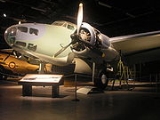
No. 4 Squadron RNZAF
Encyclopedia

New Zealand
New Zealand is an island country in the south-western Pacific Ocean comprising two main landmasses and numerous smaller islands. The country is situated some east of Australia across the Tasman Sea, and roughly south of the Pacific island nations of New Caledonia, Fiji, and Tonga...
patrol bomber unit in the South Pacific
Pacific Ocean theater of World War II
The Pacific Ocean theatre was one of four major naval theatres of war of World War II, which pitted the forces of Japan against those of the United States, the British Commonwealth, the Netherlands and France....
during World War II
World War II
World War II, or the Second World War , was a global conflict lasting from 1939 to 1945, involving most of the world's nations—including all of the great powers—eventually forming two opposing military alliances: the Allies and the Axis...
.
History
Due to activity by German surface raiders, the squadron was hurriedly formed in October 1940, initially equipped with a range of hurriedly converted civilian airliners, the twin engined de Havilland DH.89 Dragon Rapide, and four engined de Havilland DH86 Express from Union Airways of New Zealand and de Havilland DH.60 MothDe Havilland DH.60 Moth
The de Havilland DH 60 Moth was a 1920s British two-seat touring and training aircraft that was developed into a series of aircraft by the de Havilland Aircraft Company.-Development:The DH 60 was developed from the larger DH 51 biplane...
single engined machines from aero clubs - New Zealand's modern Vickers Wellington
Vickers Wellington
The Vickers Wellington was a British twin-engine, long range medium bomber designed in the mid-1930s at Brooklands in Weybridge, Surrey, by Vickers-Armstrongs' Chief Designer, R. K. Pierson. It was widely used as a night bomber in the early years of the Second World War, before being displaced as a...
bombers having been offered to the RAF for the war in Europe, two years previously.
Squadron Leader G R White was the first commanding officer and stayed with the squadron for two years. The squadron moved to Fiji
Fiji
Fiji , officially the Republic of Fiji , is an island nation in Melanesia in the South Pacific Ocean about northeast of New Zealand's North Island...
that month to assist 5 Squadron, and it took over obsolescent Vickers Vincent biplane torpedo bombers and later re-equipped with modern Lockheed Hudson
Lockheed Hudson
The Lockheed Hudson was an American-built light bomber and coastal reconnaissance aircraft built initially for the Royal Air Force shortly before the outbreak of the Second World War and primarily operated by the RAF thereafter...
s. When war with Japan broke out No. 4 Squadron remained in Fiji operating as a reconnaissance unit, and also for training crews to reinforce units in the forward area.
In May 1943 three American ships, the William Williams, Hearst and Vanderbilt, were torpedoed by Japanese submarines. Hudsons of No. 4 Squadron found the survivors of the Hurst and dropped supplies, as well as maintaining an anti-submarine patrol over the crippled William Williams was she was towed 120 miles north to Suva
Suva
Suva features a tropical rainforest climate under the Koppen climate classification. The city sees a copious amount of precipitation during the course of the year. Suva averages 3,000 mm of precipitation annually with its driest month, July averaging 125 mm of rain per year. In fact,...
.
On 25 May a squadron machine sighted a surfaced submarine while escorting an American convoy and dropped four depth-charges. An oil slick appeared - after the war it emerged a Japanese submarine was lost at this time in the area.
On 7 September a squadron Hudson damaged a second submarine while escorting the American ship Saugatuck. 5 other sightings and attacks were made by the squadron without result.
The squadron re-equipped with Lockheed Ventura
Lockheed Ventura
The Lockheed Ventura was a bomber and patrol aircraft of World War II, used by United States and British Commonwealth forces in several guises...
s in 1944. In November it shifted base to Emirau, remaining there until February 1945, Guadalcanal
Guadalcanal
Guadalcanal is a tropical island in the South-Western Pacific. The largest island in the Solomons, it was discovered by the Spanish expedition of Alvaro de Mendaña in 1568...
from May 1945 to June 1945 and Emirau again in June and July of that year before moving to Los Negros where it remained when the war ended, disbanding in September 1945.
Surviving aircraft
A Lockheed Hudson that served with the squadron is preserved in squadron colours at the Royal New Zealand Air Force MuseumRoyal New Zealand Air Force Museum
The Royal New Zealand Air Force Museum or Air Force Museum of New Zealand as it is now known, is an air force museum located located at Wigram, the RNZAF's first operational base, in Christchurch, in the South Island of New Zealand...

